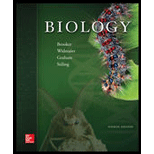
Concept explainers
Introduction: The two different modes of reproduction are sexual reproduction and asexual reproduction. The asexual reproduction involves the production of offspring with genes inherited from a single parent. The offspring is genotypically similar to the parent organism. The sexual reproduction involves the fusion of two haploid gametes to form a diploid zygote. Both the haploid gametes are from two different parents and the offspring is not an exact copy of a single parent.
Answer to Problem 1TY
Correct answer: The development of offspring from the unfertilized eggs is called parthenogenesis. Hence, the correct answer is option d.
Explanation of Solution
Reason for correct answer:
Parthenogenesis is the property of lower plants and invertebrates, such as insects, some spiders and amphibians. Even some birds reproduce by this method. In this type of reproduction, the egg produced is diploid and develops into a complete organism. This is also a type of asexual reproduction.
Option d. is given as “parthenogenesis”.
Parthenogenesis is the development of offspring from the unfertilized eggs. Hence, the correct answer is option d.
Reason for incorrect answer:
Option a. is given as “budding”.
Budding is a type of asexual reproduction, but this process does not involve the formation of an ovum. Instead, the new organism emerges out of the previously existing organism. Hence, option a. is incorrect.
Option b. is given as, “cloning”.
Cloning refer to the process of generation of genetically identical biological entity or cell. Hence, option b. is incorrect.
Option c. is given as “fragmentation”.
In this type of reproduction, the organism breaks into smaller fragments and each fragment is capable of developing into a complete individual. Hence, option c. is incorrect.
Option e. is given as, “implantation”.
Implantation is a type of sexual reproduction in which the egg is fertilized by sperm and the fertilized egg gets implanted in the wall of the uterus. Hence, option e. is incorrect.
Hence, the options a., b., c., and e. are incorrect.
The type of asexual reproduction in which the development of offspring takes place from unfertilized eggs is called parthenogenesis.
Want to see more full solutions like this?
Chapter 51 Solutions
Biology
- Skryf n kortkuns van die Egyptians pyramids vertel ñ story. Maximum 500 woordearrow_forward1.)What cross will result in half homozygous dominant offspring and half heterozygous offspring? 2.) What cross will result in all heterozygous offspring?arrow_forward1.Steroids like testosterone and estrogen are nonpolar and large (~18 carbons). Steroids diffuse through membranes without transporters. Compare and contrast the remaining substances and circle the three substances that can diffuse through a membrane the fastest, without a transporter. Put a square around the other substance that can also diffuse through a membrane (1000x slower but also without a transporter). Molecule Steroid H+ CO₂ Glucose (C6H12O6) H₂O Na+ N₂ Size (Small/Big) Big Nonpolar/Polar/ Nonpolar lonizedarrow_forward
- what are the answer from the bookarrow_forwardwhat is lung cancer why plants removes liquid water intead water vapoursarrow_forward*Example 2: Tracing the path of an autosomal dominant trait Trait: Neurofibromatosis Forms of the trait: The dominant form is neurofibromatosis, caused by the production of an abnormal form of the protein neurofibromin. Affected individuals show spots of abnormal skin pigmentation and non-cancerous tumors that can interfere with the nervous system and cause blindness. Some tumors can convert to a cancerous form. i The recessive form is a normal protein - in other words, no neurofibromatosis.moovi A typical pedigree for a family that carries neurofibromatosis is shown below. Note that carriers are not indicated with half-colored shapes in this chart. Use the letter "N" to indicate the dominant neurofibromatosis allele, and the letter "n" for the normal allele. Nn nn nn 2 nn Nn A 3 N-arrow_forward
- I want to be a super nutrition guy what u guys like recommend mearrow_forwardPlease finish the chart at the bottom. Some of the answers have been filled in.arrow_forward9. Aerobic respiration of one lipid molecule. The lipid is composed of one glycerol molecule connected to two fatty acid tails. One fatty acid is 12 carbons long and the other fatty acid is 18 carbons long in the figure below. Use the information below to determine how much ATP will be produced from the glycerol part of the lipid. Then, in part B, determine how much ATP is produced from the 2 fatty acids of the lipid. Finally put the NADH and ATP yields together from the glycerol and fatty acids (part A and B) to determine your total number of ATP produced per lipid. Assume no other carbon source is available. 18 carbons fatty acids 12 carbons 9 glycerol A. Glycerol is broken down to glyceraldehyde 3-phosphate, a glycolysis intermediate via the following pathway shown in the figure below. Notice this process costs one ATP but generates one FADH2. Continue generating ATP with glyceraldehyde-3-phosphate using the standard pathway and aerobic respiration. glycerol glycerol-3- phosphate…arrow_forward
 Concepts of BiologyBiologyISBN:9781938168116Author:Samantha Fowler, Rebecca Roush, James WisePublisher:OpenStax College
Concepts of BiologyBiologyISBN:9781938168116Author:Samantha Fowler, Rebecca Roush, James WisePublisher:OpenStax College Human Heredity: Principles and Issues (MindTap Co...BiologyISBN:9781305251052Author:Michael CummingsPublisher:Cengage Learning
Human Heredity: Principles and Issues (MindTap Co...BiologyISBN:9781305251052Author:Michael CummingsPublisher:Cengage Learning Biology (MindTap Course List)BiologyISBN:9781337392938Author:Eldra Solomon, Charles Martin, Diana W. Martin, Linda R. BergPublisher:Cengage Learning
Biology (MindTap Course List)BiologyISBN:9781337392938Author:Eldra Solomon, Charles Martin, Diana W. Martin, Linda R. BergPublisher:Cengage Learning
 Human Biology (MindTap Course List)BiologyISBN:9781305112100Author:Cecie Starr, Beverly McMillanPublisher:Cengage Learning
Human Biology (MindTap Course List)BiologyISBN:9781305112100Author:Cecie Starr, Beverly McMillanPublisher:Cengage Learning





